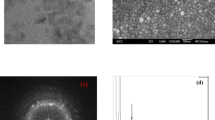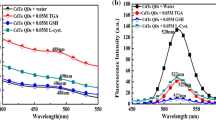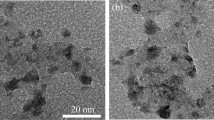Abstract
We herein report five different types of thiol dual capped cadmium tellurite quantum dots (CdTe QDs) namely glutathione-mercapto-propanoic acid (QD 1), glutathione-thiolglycolic acid (QD 2), L-cysteine-mercapto-propanoic acid (QD 3), L-cysteine- thiol-glycolic acid (QD 4) and mercapto-propanoic acid-thiol-glycolic (QD 5). Dual-capped CdTe QDs were prepared using a one pot synthetic method. Cadmium acetate and sodium tellurite were respectively used as cadmium and tellurium precursors. Photo-physical properties of the synthesized QDs were examined using UV-Vis and photoluminescence spectroscopy while structural characterization was performed by means of transmission electron microscopy (TEM) and Fourier transform infrared (FTIR) spectroscopy. The influence of pH on QD characteristics (fluorescence intensity) was studied using phosphate and citrate buffers and continuous titration with HCl (0.1 N). UV-vis and photoluminescence spectra exhibited sharp absorption band edge with high intensities and improved colloidal stability. All the QDs were found to be in nano-size rang. TEM analysis revealed the presence of spherical nanoparticles while FTIR evidenced successful dual-capping of QDs. Upon pH changes, QDs 3 and 4 demonstrated more remarkable variations in fluorescence intensity than QDs 1 and 2. The pH-sensitivity of these QDs represents a promising feature for further development of potential theranostic nano-devices.







Similar content being viewed by others
References
Muharrem S, Didem AS, Thomas S, Frank S (2017) Theranostics liposome-nanoparticle hybrid for drug delivery and bio-imaging. Int J Mol Sci 18:1415–1426
Daramola OA, Siwe Noundou X, Krause RWM, Marks JA (2017) Facile synthesis of glutathione-l-cysteine co-capped CdTe core shell system: Study on optical and structural morphology. J Nanosci Nanotechnol 17:5359–5365
Lazarovits YY, Chen YY, Sykes EA, Chan WCW (2015) Nanopartcicles-blood intercations: the implication on solid tumor targeting. Chem Commun 51:2756–2767
Chen X, Liang L, Yongxian L, Jianna Y, Yichen T, Xiuli W (2015) Microwave-assisted synthesis of glutathione-capped CdTe/CdSe near-infrared quantum dots for cell imaging. Int J Mol Sci 16:11500–11508
Kim J, Huy BT, Sakthivel K, Choi HJ, Joo WH, Shin SH, Lee MH, Lee YI (2015) Highly fluorescent CdTe quantum dots with reduced cytotoxicity- A robust biomarker. Sens BioSensing Res 3:46–52
Fontana JM, Huijuan Y, Yun C, Ricardo F, Hjalmar B, Ying F (2017) Transport and release of colloidal 3-mercaptopropionic acid-coated CdSe–CdS/ZnS core-multishell quantum dots in human umbilical vein endothelial cells. Int J Nanomedicine 12:8615–8629
Gao X, Cui Y, Levernson RM, Chung LW (2004) In vivo cancer targeting and imaging with semiconductor quantum dot. Nat Biotechnol 22:969–976
Gaponik N, Andrey LR (2010) Thiol-capped CdTe nanocrystals: progress and perspectives of the related research fields. J Phys Chem A 12:86–93
Raju SP, Hareesh K, Chethan PS, Dhole SD, Sanjeev G (2017) ZnS shell growth on thiol capped CdTe quantum dots using gamma irradiation. AIP 1832:1–4
Oluwafemi SO, Daramola OA, Vuyelwa N (2014) A facile green synthesis of type II water soluble CdTe/CdS core shell nanopartices. Mater Lett 133:9–13
Wu S, Jun D, Jie Z, Shurfen Z (2011) A simple and economical one-pot method to synthesize high-quality water soluble CdTe QDs. J Mater Chem 22:14573–14578
Vuyelwa N, Sundararajan P, Sandile PS, Tetsuya K, Oluwatobi SO (2017) Simple green synthesis of amino acid functionalised CdTe/CdSe/ZnSe core-multi shell with improved cell viability for cellular imaging. Mater Lett 189:168–171
Yu Y, Xu L, Chen J, Gao H, Wang S, Fang J, Xu S (2012) Hydrothermal synthesis of GSH-TGA co-capped CdTe quantum dots and their application in labelling colorectal cancer cells. Colloids Surf B 95:53–247
Adegoke O, Nyokong T (2013) Probing the sensitive and selective luminescent detection of peroxynitrite using thiol-capped CdTe and CdTe@ZnS quantum dots. J Lumin 134:448–455
Mark G, Peter W, Marketa S, Jason D, Sergio B, Peter D, Franco (2009) Synthesis of type II/type I CdTe/CdS/ZnS quantum dots and their use in cellular imaging. J Mater Chem 19:8341–8346
Liu YF, Yu JS (2009) Selective synthesis of CdTe and high luminescence CdTe/CdSe quantum dots: The effect of Ligands. J Colloid Interface Sci 333:690–698
Lihong J, Stephen VK, Yilin L, Xiaodan H, Yingying L, Andrey LR, Mingyuan G (2016) Aqueous based semiconductor nanocrystals. Chem Rev 116:10623–10730
Fang Z, Liu L, Xu LL, Yin XG, Zhong XH (2008) Synthesis of highly stable dihydrolipoic acid capped water-soluble CdTe nanocrystals. Nanotechnology 19:23–30
Zhang J, Li J, Zhang JX, Xie RG, Yang WS (2010) Aqueous synthesis of ZnSe nanocrystals by using glutathione as ligand: The pH-mediated coordination of Zn2+ with glutathione. J Phys Chem C 114:11087–11091
Estrella V, Chen T, Lloyd M et al (2013) Acidity generated by the tumor micro environment drives local invasion. Cancer Res 5:1524–1535
Krezel A, Bal W (1999) Coordination chemistry of glutathione. Acta Biochim Pol 146:567–580
Acknowledgements
This work was supported by the Sandisa Imbewu Programme of Rhodes University. The assistance from the WSU Chemistry Department and the Directorate of research is gratefully acknowledged. We are also grateful for the opputunity given to us by the organizer of the conference tagged “Nano World Summit: Future and Current Perspective’’ to present part of this work during the conference proceedings which was held in philadelphia, USA, 6th – 7th of June 2018.
Author information
Authors and Affiliations
Corresponding authors
Ethics declarations
Conflict of Interest
The authors declare no competing interests.
Additional information
Publisher’s Note
Springer Nature remains neutral with regard to jurisdictional claims in published maps and institutional affiliations.
Rights and permissions
About this article
Cite this article
Daramola, O.A., Siwe Noundou, X., Nkanga, C.I. et al. Synthesis of pH Sensitive Dual Capped CdTe QDs: Their Optical Properties and Structural Morphology. J Fluoresc 30, 557–564 (2020). https://doi.org/10.1007/s10895-020-02526-x
Received:
Accepted:
Published:
Issue Date:
DOI: https://doi.org/10.1007/s10895-020-02526-x




